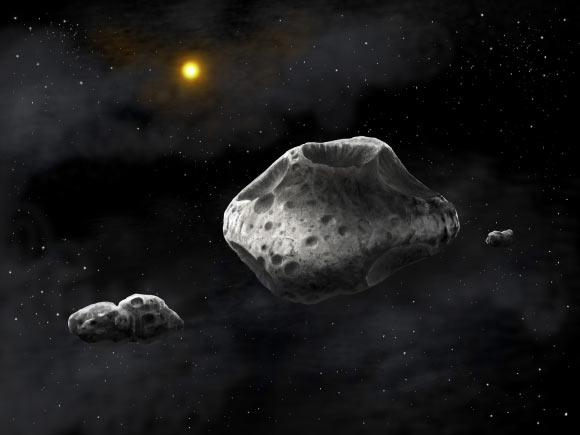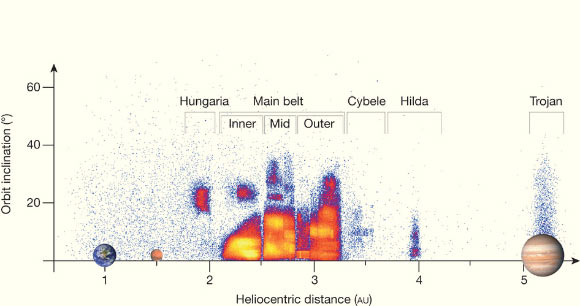Planetary scientists from Massachusetts Institute of Technology and European Space Astronomy have created a map of more than 100,000 asteroids throughout the Solar System, revealing the size, composition and location of each asteroid and showing that so-called ‘rogue’ asteroids are actually more common than previously thought.

This is an artist’s impression of the triple asteroid system Sylvia. The two moons, Romulus and Remus, are shown to be strongly elongated, and composed of two lobes. Image credit: Danielle Futselaar / SETI Institute.
To create the asteroid map, Dr Francesca DeMeo and Dr Benoit Carry first analyzed data from the Sloan Digital Sky Survey. To avoid any bias in their mapping, the scientists determined that the survey most likely includes every asteroid down to a diameter of 5 km. At this size limit, they were able to produce an accurate picture of the asteroid belt.
They grouped the asteroids by size and composition, and mapped them into distinct regions of the Solar System where the asteroids were observed.
From their map, the scientists observed that for larger asteroids, the traditional pattern holds true – the further one gets from the Sun, the colder the asteroids appear.
But for smaller asteroids, this trend seems to break down. Those that look to have formed in warmer environments can be found not just close to the Sun, but throughout the Solar System – and asteroids that resemble colder bodies beyond Jupiter can also be found in the inner asteroid belt, closer to Mars.

This image shows the location of the main asteroid belt with respect to the planets and the Sun as well as the orbital structure of asteroid inclinations and number density of objects – yellow represents the highest number density, blue the lowest. The structure of the belt is divided by unstable regions, seen most prominently at 2.5 and 2.8 astronomical units. Image credit: F. E. DeMeo & B. Carry.
The new map suggests that the early Solar System may have undergone dramatic changes before the planets assumed their current alignment.
Jupiter may have drifted closer to the Sun, dragging with it a host of asteroids that originally formed in the colder edges of the Solar System, before moving back out to its current position. Jupiter’s migration may have simultaneously knocked around more close-in asteroids, scattering them outward.
“It’s like Jupiter bowled a strike through the asteroid belt,” said Dr DeMeo, who is the first author of a paper published in the journal Nature.
“Everything that was there moves, so you have this melting pot of material coming from all over the Solar System.”
The astronomers said the map will help them flesh out theories of how the Solar System evolved early in its history.
______
F. E. DeMeo & B. Carry. 2014. Solar System evolution from compositional mapping of the asteroid belt. Nature 505, pp. 629–634; doi: 10.1038/nature12908







